
VINTAGE ST. PETE is a series focused on our city’s illustrious (and occasionally notorious) past. Many of these features have appeared in the Catalyst over the past 2 1/2 years, and new stories (like this one) will be added as time goes on.
On a narrow stretch of sand in the town of Indian Shores, the earth has reclaimed Tiki Gardens. The tidy footpaths that meandered past neatly-manicured palm trees and flowering bushes, grass huts and painted stucco Tiki statues are covered now with greenbrier vines, scrub palmetto and 30 years of the matted, decayed detritus of palm, pine and invasive Brazilian pepper trees.
Once, this was paradise.
The lagoon and canals dredged in the early 1960s are still there, but they’re muddy and formless, their limerock borders having caved in long ago. The wooden footbridges are gone. The tide still comes in from Boca Ciega Bay, at the back of the site, but the mangroves and sea grapes, long unchecked, have created a thick and impenetrable wall.
These 12 overgrown acres were home to one of the most popular tourist destinations in Florida. In the pre-Disney era, Tiki Gardens attracted 500,000 visitors annually.
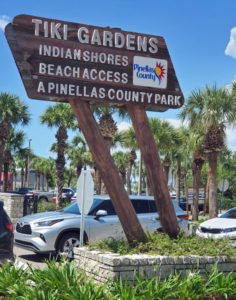
It finally ran out of gas in 1988, and today the property is county-owned, with the paved acreage that fronts Gulf Boulevard serving as a beach access parking lot. Traffic rolls past; families pull in, park and unpack beach chairs and umbrellas, chattering happily as they walk across the two-lane road and beeline for the hot white sand of the Gulf.
Behind the chain link fence, however, the only sounds are the rustle of something slithery underfoot, the call of a passing gull and the occasional splash of young fish, spawned in the brackish water between the protective roots of the mangroves.
On so many long-ago nights, the air was filled with the loud bray of peacocks, the whooping of monkeys, and the voice of Frank Byars, the owner and ringmaster of Tiki Gardens, the namesake of Trader Frank’s restaurant, on the wind:

Aloha, ladies and gentlemen, we’re broadcasting live direct from beautiful, exotic Tiki Gardens, right here from the heart of the gardens. From our broadcast booth, here’s Ernie Shreeves on the Wurlitzer, bringing you a beautiful medley of Hawaiian tunes. We’re bringing you torch-lighting. We do this each evening at twilight. So we extend to you a most cordial invitation to join with us, just as the sun goes down. Right here at beautiful, exotic Tiki Gardens, when we bring you the ceremony of the lighting of the torches. Aloha.
(The organist plays “Blue Hawaii,” “Aloha O’e,” “Beyond the Reef” and “Lovely Hula Hands.” Palm trees, presumably, sway. Umbrella drinks are consumed from coconut shell mugs.)
Frank Byars ran away from his South Carolina home at the age of 14, and learned the hard way about the value of a dollar. He was a hard worker. From the day he arrived in the Tampa Bay area in the early 1930s until his death in 1995, at the age of 85, Byars was hustling. “Nothing happens until somebody sells something” was his motto, oft-repeated.
Frank and his bride Jo Miller Byars – they met in Tampa – managed a North Pinellas beach motel and sold her jewelry, crafted from local shells, out of a tiny souvenir shack. In the early ‘50s, they purchased the property at 19601 Gulf Boulevard, in what was then known as Indian Rocks Beach South Shore.
 They called their new souvenir business the Signal House, and in time it became the biggest retail outlet in the area, consisting of several small, themed gift shops selling Oriental clothing, baskets, driftwood and other ephemera (“Truly a phantasmagoria of shoppers’ delights!” screamed their bright orange tourist brochure) and a small, florid garden walkway with a South Seas Island theme. Tiki Gardens, as they named it, was just a hook to keep visitors in the shops a little longer.
They called their new souvenir business the Signal House, and in time it became the biggest retail outlet in the area, consisting of several small, themed gift shops selling Oriental clothing, baskets, driftwood and other ephemera (“Truly a phantasmagoria of shoppers’ delights!” screamed their bright orange tourist brochure) and a small, florid garden walkway with a South Seas Island theme. Tiki Gardens, as they named it, was just a hook to keep visitors in the shops a little longer.
Frank Byars served on the South Shore Town Council, and as President of the Indian Rocks Beach Chamber of Commerce. He once ran, unsuccessfully, for mayor.
In May 1963, the Signal House was destroyed by fire. Undeterred, the couple made plans to rebuild, enlarging the gardens and making the gift shops part of a central complex that would include a 450-seat restaurant called Trader Frank’s.
“We’d always dreamed about the South Seas.” Frank Byars told the St. Petersburg Times in 1978. “So we researched it to see if there were any other attractions in the state with a Polynesian atmosphere. We found there were none.
“We talked to two or three architects about building it, and none of them wanted to touch it. So we bought some brown wrapping paper, and every morning Jo would draw the pictures on the paper, and the builders would build from that. We built the whole thing that way.”
Artist Gordon Keith designed the tiki heads to the Byars’ specifications.
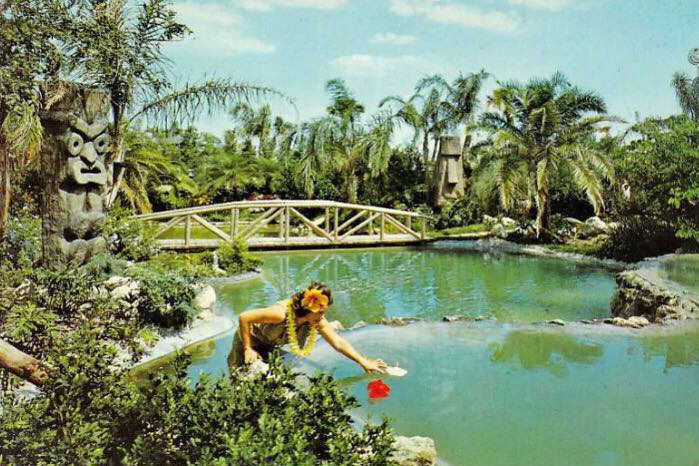
Tiki Gardens open March 15, 1964. Admission to walk the scenic “Polynesian Adventure Trail,” with its tall, foreboding tikis around every bend, was $1.25 for adults, 50 cents for children.
Admission to the gift shops, of course, was free. It was all part of the Tiki Gardens experience.
We’d like to suggest that someday you take your best girlfriend and your camera and visit our island paradise. Out there you’ll find the King’s Fish Pond, Fire Mountain – the highest promontory in Pinellas County – thousands of beautiful birds, a monkey village to entertain the kids. We say it’s a place to dream a while – beautiful, exotic Tiki Gardens.
America was going through a “tiki” craze in the late 1950s and early ’60s, with South Seas imagery and design affecting everything from art and architecture to music and movies. The hospitality industry, naturally, found a way to exploit the exotic escapism presented by the all-consuming fad.
Frank and Jo Byars had never been to Hawaii or the South Seas, but they were swept up in tiki-mania – and Frank, in particular, was quick to realize there was a buck to be made.

They sold a little bit of everything in the gift shops, remembers tiki enthusiast Jon Bortles, who’s writing a book about Frank and Jo Byars. “They sold baskets, they sold fine china. Anything Frank thought tourists might want to buy, they sold it. They sold menswear, and not everything had the Hawaiian motif. I have a tie with racehorses on it, and the Tiki Gardens label.”
A native of Clearwater, Bortles remembers visiting Tiki Gardens as a child, with his family. The tiki heads, he recalls, were imposing and scary. It was only after he grew up and started doing research on Polynesian culture that he realized what a strange mash-up Tiki Gardens really was.
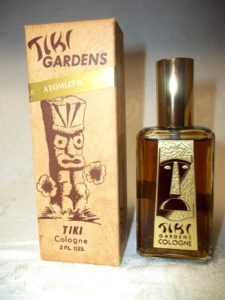 “A lot of the decorations were painted and designed by Jo who, bless her heart, probably didn’t do a whole lot of research into stuff,” he says. “People who are seriously into Polynesian art today look at some of it, and they’re scratching their heads.”
“A lot of the decorations were painted and designed by Jo who, bless her heart, probably didn’t do a whole lot of research into stuff,” he says. “People who are seriously into Polynesian art today look at some of it, and they’re scratching their heads.”
It was, Bortles says, common practice for movies of the era to blithely blend imagery from different cultures. Tiki Gardens was no exception.
“You’ve got Polynesian things, but right next to them you’ve got something from Alaska. Or things from Indonesia. Or African masks. Anything that was considered kind of exotic, nobody really went into the history of it. Hawaii, Tahiti, Fiji, Micronesia, they were all lumped into one group. Frank used to buy masks that were made in South America, and put them up for sale as tiki masks.”
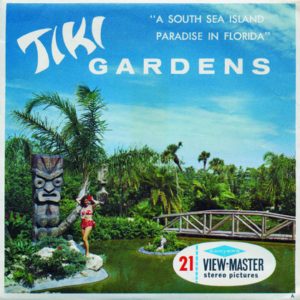 A record album, Exotic Sounds of Tiki Gardens: A Fabulous Audio Fantasy, was produced in 1967 and sold exclusively in the gift shop. Prized by tiki collectors today, the limited-edition private pressing is a fascinating time capsule, as Frank (on Side One) and Jo (Side Two) breathlessly describe their “South Seas Island Paradise.”
A record album, Exotic Sounds of Tiki Gardens: A Fabulous Audio Fantasy, was produced in 1967 and sold exclusively in the gift shop. Prized by tiki collectors today, the limited-edition private pressing is a fascinating time capsule, as Frank (on Side One) and Jo (Side Two) breathlessly describe their “South Seas Island Paradise.”
It’s part “you are there” audio verité and part P.T. Barnum salesmanship.
Following the horn-blowing, drum-pounding accompaniment to the torch-lighting ceremony, Frank – speaking with a thick Southern drawl – introduces “Direct from the Islands, Princess Carloa,” who croons Elvis Presley’s “Hawaiian Wedding Song” in a tremulous soprano voice. She is identified in the back-cover credits as Carla Perry.
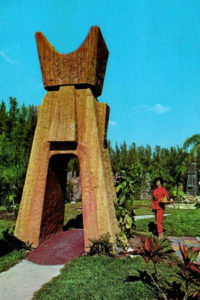
Thank you Princess, really beautiful. And now, the little wahines are leaving to light the torches in big Tiki Gardens. Here you’ll find an island paradise. The lighting effects at night are simply fantastic. You should go out and see ‘em. It’s one of Florida’s major attractions. We call it our Polynesian Fantasy At Night. This concludes our ceremony here in the little garden. We hope you’ve enjoyed it. It’s been our real pleasure to bring you this ceremony. We do this each evening at twilight, in an effort to make your stay in Florida, and your visit to Tiki Gardens, a little bit more pleasant.
And so now, let’s on with the luau! Let’s over to Trader Frank’s for one of those delightful teriyaki steak dinners. Let’s browse the eight shops, they’re all jammed with interesting items from the exotic marketplaces of the world! Let’s take a stroll on beautiful Pier Kahiki, or visit the Polynesian Fantasy, beautiful, exotic Tiki Gardens. And as they say in Hawaii, until we meet again, aloha.
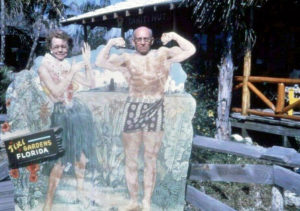
Trader Frank’s didn’t have an elaborate tiki-themed floor show; Ernie Shreeves on the keyboard provided the entertainment at the 450-seat restaurant. He was also a homebuilder and, in the 1970s, a pioneer in the development of solar energy. Shreeves’ daughter, Lynn Shreeves Dixon, remembers him as a “jack of all trades.”
Dixon was born the year her dad performed on the Byars’ souvenir record album. As a child, she had the run of Tiki Gardens. “I thought it was normal, go see Aunt Jo and Uncle Frank,” Dixon says. “You had your favorite tikis as you ran along the paths, exploring. Peacocks everywhere. And It was great at night when they had the tiki torches out. It was really magical.”

Her parents were friendly with the Byars, who lived just up the road, on the beach side of Gulf Boulevard. “They loved the culture. When we’d stay at their house, they had these little books and I’d read about the gods of Hawaii, and all the different cultures of that area of the world.”
Frank and Jo had begun making trips to the island every other year or so. Frank bought up every trinket he could lay his hands on, wholesale, and brought them all back to re-stock his shelves.
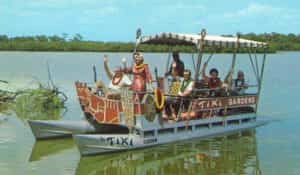
For Exotic Sounds of Tiki Gardens, Frank field-recorded “the mating call of the proud peacock” (approximately 50 of the large, loud birds were free to roam the grounds), the wild parakeets in the bell tower, a barking wooly monkey named Chester, the talking mynah birds (“Frank and Jo”), the cooing of doves and the lapping of waves.
On Side 2, Jo took over for more of the same:
On an island, near a windswept beach, lies a little bit of paradise called Tiki Gardens. During the next few moments, we will transport you there by sound, captured on a trip through this land of enchantment. In the background: The theme song of Tiki Gardens, inspired by its romantic beauty. Come with us as we thrill to the exotic sounds of this Polynesian fantasy.
This was Ernie’s spotlight, as he played his original composition, “Tiki Gardens Polynesian Fantasy,” overdubbing piano on top of his Wurlitzer organ. Strangely, the song is repeated several times, decorated with the same loop of shrieking peacock sounds we heard on Side One, then the monkeys and the doves, and the lapping waves, and seagulls, and what sounds like it’s supposed to be an erupting volcano.
The fourth time it comes along, someone has added Hawaiian steel guitar, creating the most islandy-sounding moment on the entire record, classic exotica:
Frank and Jo Byars’s only child, daughter Sherry Jo, had died of cancer during the Signal House era, at age 16; they later established a scholarship in her name at Eckerd College. With no family to speak of, they poured everything they had – their time, talents, energy and money – into Tiki Gardens.
“We think of Tiki Gardens as the place to dream awhile,” Frank told the Tampa Tribune in 1987. “All the other attractions emphasize excitement. Here, people can think about the things that have happened to them, and those that might happen.”
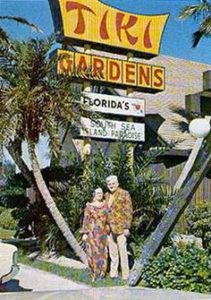
Ultimately, like all roadside attraction owners, the Byars were forced to concede that Disney, and the other excitement-generators, were unbeatable. By the 1980s, business at Tiki Gardens was falling off; the tiki craze, of course, had passed into history and was considered no more than kitsch. Hurricane Elena in 1985 left sections of the trail in ruins.
Age was catching up with them, too. It was time to go. Frank and Jo accepted an offer of $2.95 million from a pair of Australian investors in 1988 (including, reportedly, $1 million in rare black opals). They opened a small souvenir shop, Fun & Sun, in Johns Pass Village.
The Australians’ attempts at keeping Tiki Gardens operating failed, and in 1990 the property was sold to Pinellas County for $3 million (no opals were exchanged). The tikis, the birds and animals, the pontoon boats and the contents of the restaurant and gift shops were sold at auction. The buildings were taken apart and the rest was bulldozed.
Jo Byars passed away in August 1994; Frank followed 14 months later.

At 19601 Gulf Boulevard there’s no trace of Tiki Gardens, and the significant role it played in the growth of Pinellas County tourism, except for a small sign at the entrance to the 170-space parking lot that proclaims the area is now known – rather unromantically – as Tiki Gardens Park Beach Access.
Behind the fence, however, there remains a ghostly voice on the twilight breeze. It’s Jo Byars.
And now we leave this land of enchantment, intrigue and mystery, hoping someday to return to this paradise, to walk again amongst the giant Tiki gods, who stand majestically guarding the secrets of the past. We say aloha.

